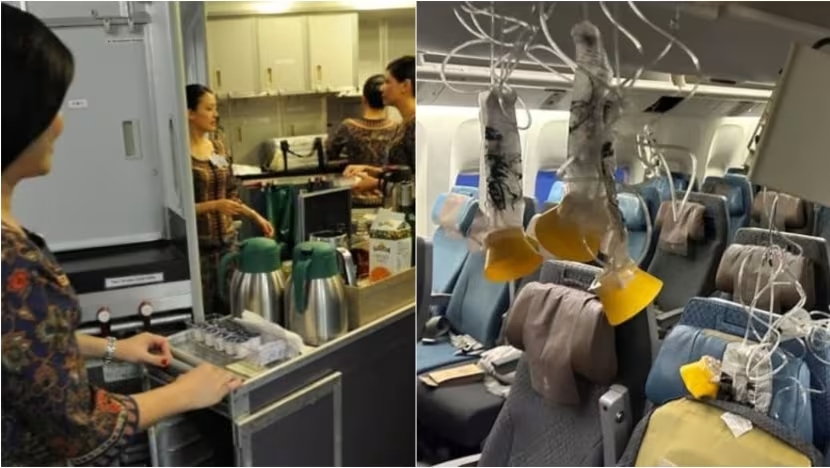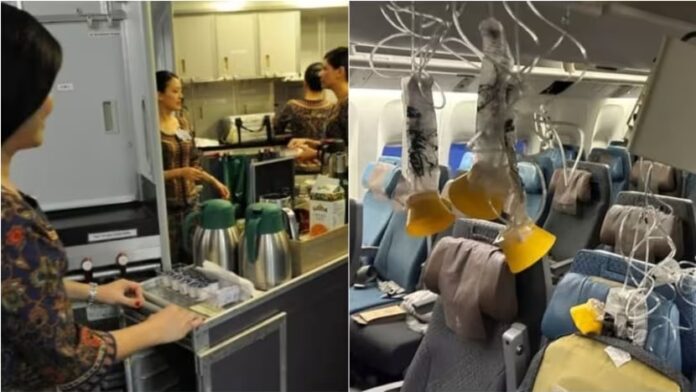While SIA’s crisis management efforts have been lauded, the safety and security of air travel will be on the minds of passengers and airlines alike, says Endau Analytics’ Shukor Yusof.

File photo of SIA cabin crew (left) and the interior of Singapore Airlines flight SQ321 after an emergency landing at Bangkok’s Suvarnabhumi International Airport on May 21, 2024. (Photos: AFP, Reuters)
SINGAPORE: Air travellers everywhere must have followed news of turbulence-hit Singapore Airlines (SIA) flight SQ321 with a shudder – another one of the many fears about flying that have become reality recently.
On Tuesday (May 21), the Boeing 777-300ER jet met sudden severe turbulence over the skies of Myanmar, which sent some passengers crashing into the overhead compartments. One death has been reported and many were injured, some critically.
Airlines have emergency protocols and crisis management teams, all with the hopes of never needing to activate them. The immediate aftermath of air incidents can be challenge: Staff may be in a state of shock or confusion, passengers unattended, and information scant, often uncertain.
By most accounts, SIA’s actions in the air and on the ground were exemplary and are a lesson in crisis response for other carriers.
EXEMPLARY CRISIS RESPONSE
SIA’s rapid actions and clear communications have been widely lauded, starting with the pilot’s decision to land in Bangkok, instead of Yangon. The airline has a bigger station in the Thai capital and medical facilities there could cope better with the emergency.
One passenger Josh Silverstone praised the cabin crew for checking on people despite several being themselves badly hurt. Another passenger, Andrew Davies, recalled that the flight attendants were “stoic and did everything they could”.
The jet was met at Suvarnabhumi Airport by ambulances and medical workers who ferried victims to nearby hospitals. Malaysia student Dzafran Azmir lauded the airport and SIA staff for taking care of injured and uninjured passengers.
By that evening, an SIA relief plane left for Bangkok. SIA CEO Goh Choon Phong met returning passengers on arrival early Wednesday morning and also flew to meet those still in Bangkok.
Preparedness and a strong culture of safety are critical.
Five months earlier, the world witnessed how a calm and collected Japan Airlines crew swiftly steered all 367 passengers out of a burning Airbus A350 at Haneda airport, with no major injuries. Their rigorous training, including 90-second evacuation drills, paid off.
That is not to say SIA’s handling of the SQ321 incident has been flawless. An injured passenger complained that SIA had not been forthcoming with information. SIA has apologised to him.
HARD-EARNED LESSONS
Good crisis response and communications is hard work. And SIA showed it has learnt from its last fatal aviation incident 24 years ago.
In October 2000, an SIA Boeing 747-400 scheduled for Los Angeles took off from the wrong runway at Taipei airport during a typhoon, which resulted in a horrific crash that killed 83 people.
That tragedy was marred by initial confusion and miscommunication, after inaccurate and uncorroborated information were made public, causing widespread anger and criticism.
Few airlines cope well when things go awry.
Last year, American discount carrier Southwest Airlines was fined US$140 million for its shambolic cancellation of 17,000 flights due to a winter storm during Christmas 2022 that left 2 million passengers stranded. Southwest had been criticised for not taking responsibility during the crisis and its poor communications.
How airlines treat its passengers during a crisis helps cement brand loyalty.
SIA has a track record of very good customer service, though there have been complaints about declining standards in recent months from disgruntled passengers, including those in its elite Solitaire PPS Club.The airline’s handling of SQ321 will go some ways in quelling critics of its peacetime faults and reassure them that they are in good hands when it really matters.
RISKS AND HAZARDS FACING AIRLINES
Still, airlines must be nervous after the SQ321 incident: Air travel is fraught with risks beyond the industry’s control, from pandemics and natural disasters to geopolitical instability.
Aviation suffered greatly during the COVID-19 pandemic, when airlines around the world grounded their fleets and laid off or cut the salaries of many workers.
In the past two years, conflicts in Ukraine, Gaza and Iran have forced airlines to avoid large swathes of airspace in the Middle East and Europe, causing flights to be rerouted, resulting in loss of time and money.
In recent months, some flights in Indonesia were cancelled due to volcanic eruptions. Volcanic ash can damage plane engines and cause aircraft to stall.
Then there are weather hazards. Besides turbulence, other challenges include wind shear, icing and weather conditions that require pilots to fly primarily by reference to flight instruments instead of visual references (known as instrument meteorological conditions).
AIR SAFETY AND ARTIFICIAL INTELLIGENCE?
That said, flying is still the safest mode of transportation.
According to an International Air Transport Association (IATA) safety report, there were 39 commercial aviation accidents in 2022, resulting in 158 deaths. That’s one accident for every 0.83 million flights.
Still, the industry is looking for ways to make air travel safer and hassle-free.
Experts have begun work on using artificial intelligence (AI) for optimised flight paths that can prevent delays, predictive maintenance to ensure a plane’s airworthiness and more accurate weather forecasts.
AI algorithms, that can analyse vast amounts of data from various sources, could help pilots and air traffic controllers make better informed decisions and reduce human error.
From preventing accidents to minimising loss and managing the crisis when they do, safety and security are non-negotiable in aviation.
Shukor Yusof is the founder of Endau Analytics, an independent aviation advisory firm based in Singapore.






